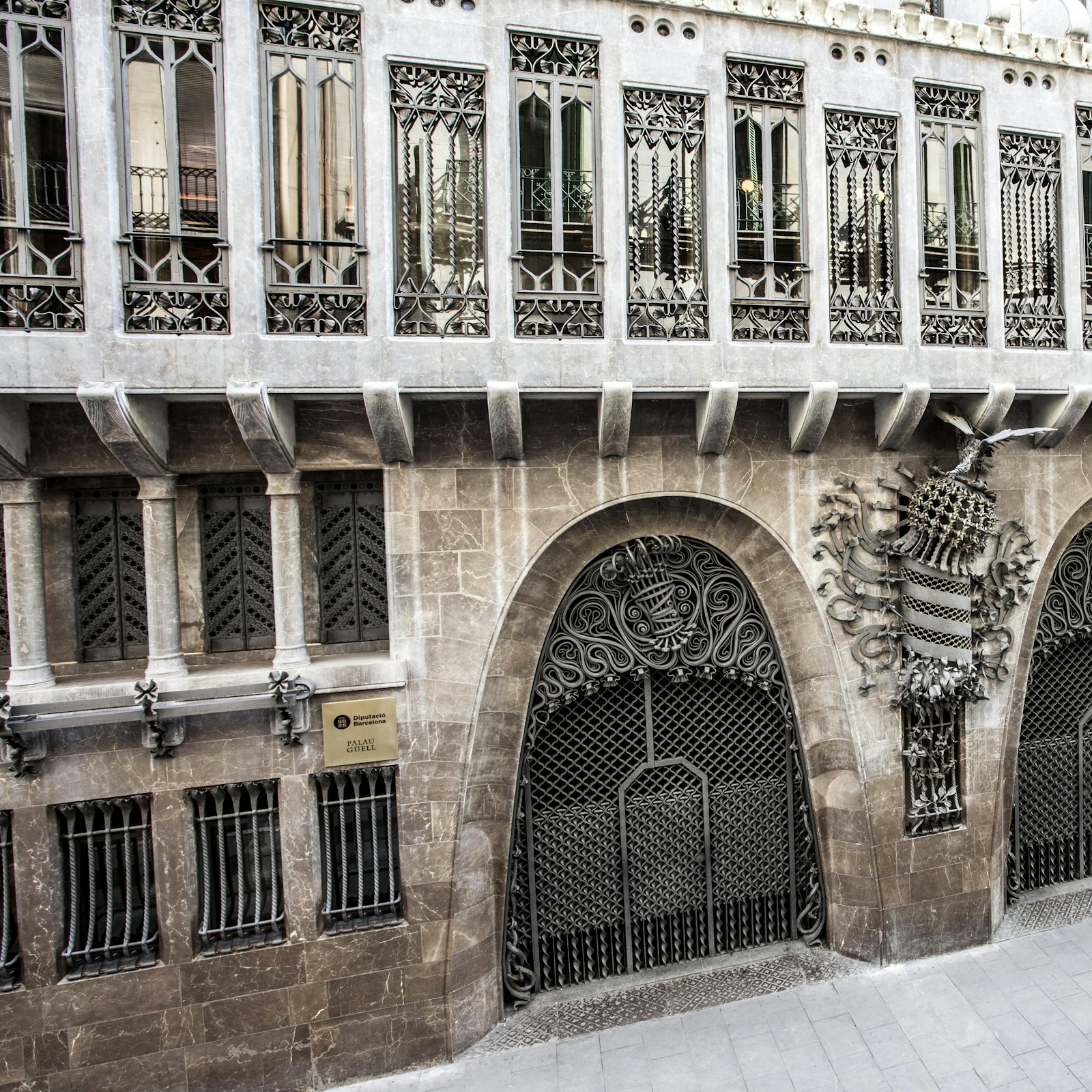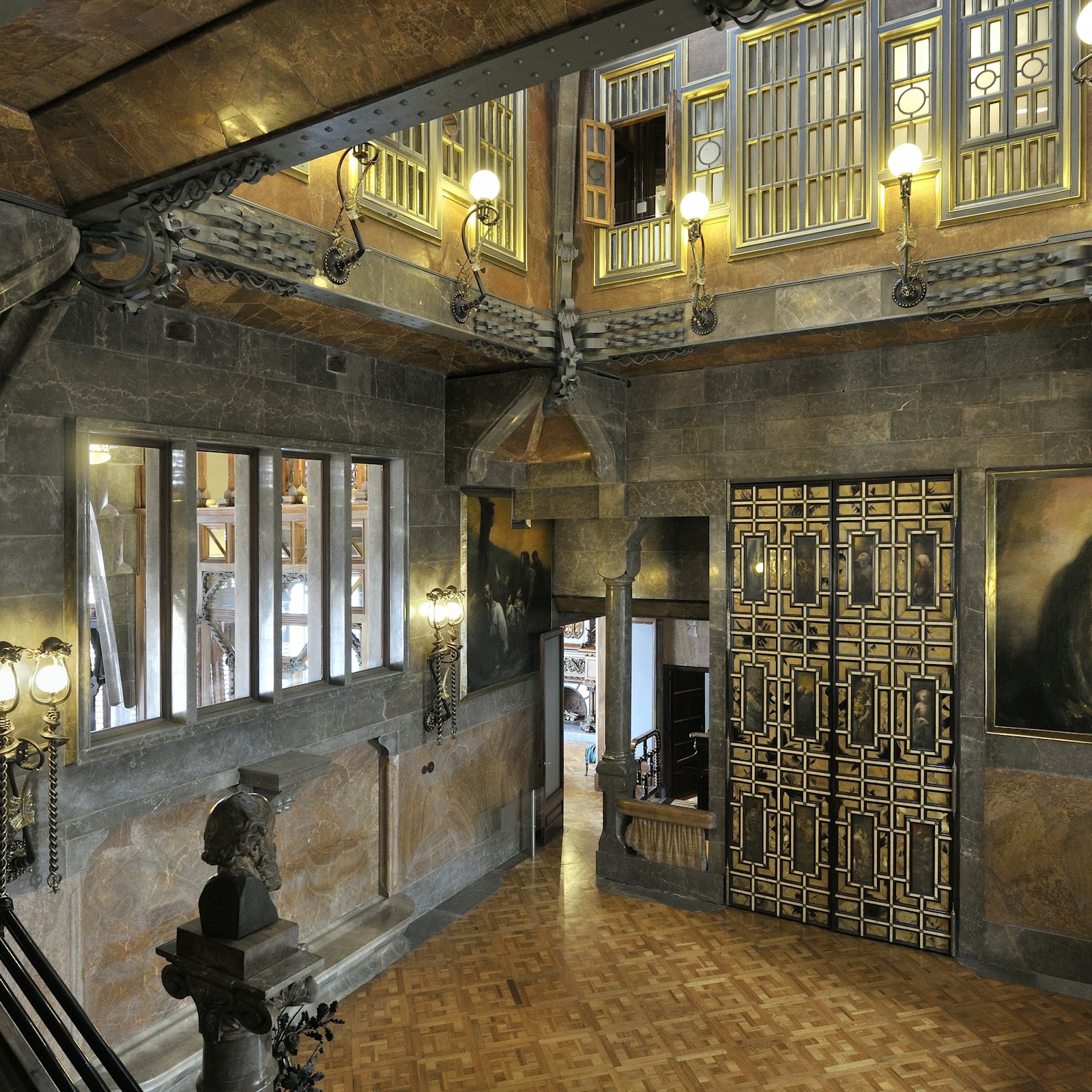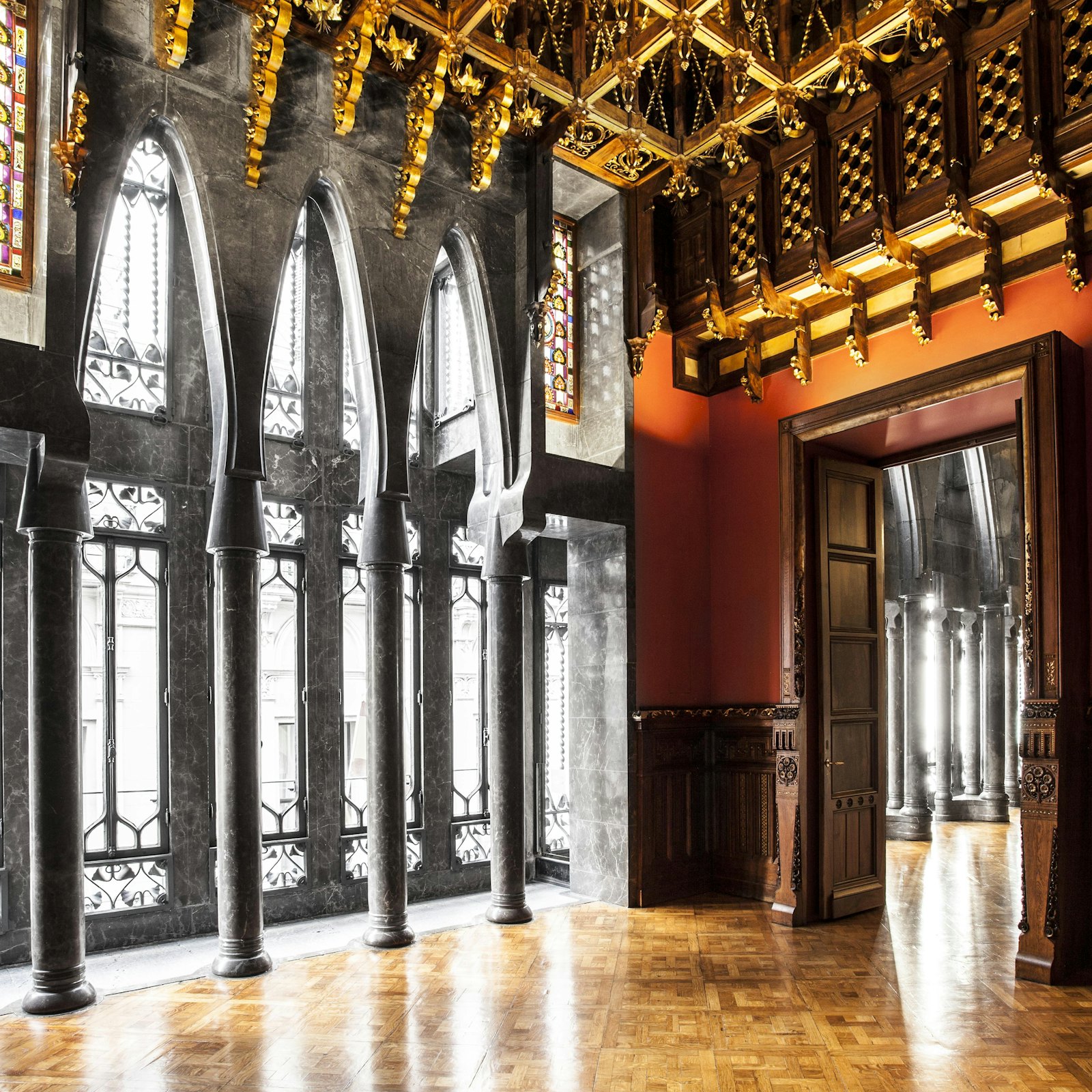Palau Güell (Güell Palace): Entry Ticket
Another Gaudi Masterpiece in Barcelona
- Palau Güell: Skip The Line Entry Ticket
- Access to all visitable areas of the building, including the rooftop
- Downloadable or physical audio guide in 13 languages (options: general, express, and kids)

Palau Güell (Güell Palace) Tickets and Information
- Palau Güell (Güell Palace) Address: 3-5 Carrer Nou de la Rambla, 08001, Barcelone
- Summer Opening Hours: Daily from 10:00 - 20:00 (Last Entry at 7PM)
Is Palau Güell (Güell Palace) Worth Visiting
- Palau Güell (Güell Palace) is a must if you are a Gaudi fan, in our opinion, yes.
- It may not be his most famous property and design but definitely worth the time, in our opinion.
What You See At Palau Güell (Güell Palace)
- The house
- The rooftop
- The architecture
{{ticket-block-triple}}
About Palau Güell (Güell Palace)
Amongst Barcelona's famous landmarks with incredible architecture is Palau Güell (Güell Palace), in the 'El Raval' neighbourhood. The magnificent palace was designed by the illustrious Catalan architect Antoni Gaudí at the beginning of his career and it shows his extraordinary genius and unique architectural style that has come to define Barcelona's landscape, alongside other notable works such as the Sagrada Familia, Casa Batlló, and Casa Milà - La Pedrera.
Palau Güell was one of Gaudí's first collaborations with Eusebi Güell, the patron behind Park Güell, and it helped to establish a partnership that blossomed into a lifelong friendship between the two.
The palace was built as a residence for the Güell family as well as a venue for their social and cultural events. Its design includes a grand reception hall, a chapel, a main room for entertaining guests, various living quarters, and stables which are located beneath the property. The property stands as a testament to Gaudí's innovative vision and lasting impact on the city's architectural legacy.
From the moment you arrive at the UNESCO World Heritage Site, it’s evident that it's not an ordinary property. The elaborate ironwork on the gates sets the stage for the visual feast that awaits inside.
As you enter, the light and dark spaces immediately captivate you, each enhancing the other in a delicate balance. Gaudí’s use of colour brings it to life, while his masterful manipulation of natural light creates dynamic interactions with both shadowed and illuminated spaces, something that most of us just wouldn't even think of! If this is your first time at a Gaudí creation, it will likely mark the beginning of a newfound appreciation for his work and visits to other properties in Barcelona!
Wandering through the interconnected rooms, you see different aspects of Gaudí’s genius - from the use of wood and stained glass to the symbolic elements that are seamlessly woven into the architecture. The centrepiece of Palau Güell is the central hall with its parabolic dome, which is a blend of engineering mastery and artistry.
Don't forget to visit the incredible rooftop, with its whimsical chimneys and amazing views of Barcelona. Palau Güell is more than just a building, it's a journey through time and artistic expression. Gaudí’s visionary designs provide a window into his mind and the luxurious heritage of Barcelona’s architecture.
Gaudí, who is often hailed as the father of Catalan Modernism, infused Palau Güell with his distinctive architectural style. The construction spanned a decade, from 1886 to 1896, with subsequent modifications continuing until 1906 when the 'masterpiece' was finally complete. The palace eventually became a focal point for artistic expression and cultural gatherings.
As the 20th century progressed, Palau Güell faced neglect and deterioration. Restoration efforts began in the 1980s which aimed to preserve the physical structure and show its historical and artistic significance. Palau Güell is now a meticulously preserved time capsule that allows you to step back in time and witness the grandeur of a bygone era. Recognised as a UNESCO World Heritage Site in November 1984, it remains a testament to Gaudí's genius.
One of the distinctive features of Palau Güell is its innovative use of space and light. Gaudí's love of organic designs which were inspired by nature, is reflected in the palace’s seamless integration of form and function. The façade is covered with intricate ironwork, which is a hallmark of Gaudí's style, while the interior boasts a series of interconnected rooms that were designed to facilitate the flow of light and air.
Gaudí's creations often contain symbols, and Palau Güell is no exception. The palace features motifs from nature, religious symbolism, and the incorporation of the owner's family crest. The rooftop chimneys which are sculpted into fantastical shapes resembling warriors and knights, are a prime example of Gaudí's symbolic storytelling.
Beyond its role as a tourist attraction, Palau Güell continues to serve as a cultural venue. The palace hosts various events throughout the year, including concerts, exhibitions, and lectures, adding a contemporary layer to its historical significance. The dynamic use of space aligns with Gaudí's vision of architecture as a living, evolving entity that engages with the community.
Palau Güell may not be the most famous of Gaudi's designs but it is most definitely worth taking the time to visit it and it is still one of the most popular attractions in Barcelona.
Popular Tickets
Popular Attractions
Palau Güell (Güell Palace) FAQs
- What is Palau Güell?
- Palau Güell is a property that was designed by the famous Catalan architect Antoni Gaudí for the industrial tycoon Eusebi Güell. The house is located in the 'El Raval' neighbourhood of Barcelona and is one of Gaudí's early works, which he completed between 1886 and 1888. The palace is renowned for its innovative use of space, light, and materials, and it represents a significant early example of Gaudí's unique architectural style.
- Why is Palau Güell significant?
- Palau Güell is significant because it was one of the first major commissions for Gaudí and showcases many elements of his developing style, such as intricate ironwork, organic forms, and the use of natural light. The building is a UNESCO World Heritage Site and is recognised for its outstanding universal value and its contribution to the Modernisme (Catalan Art Nouveau) movement.
- What architectural features make Palau Güell unique?
- Palau Güell is unique for several reasons, including its parabolic arches, intricate ironwork, and the use of high-quality materials like marble and wood. The central hall's parabolic dome allows natural light to filter through the upper floors. The rooftop chimneys are covered in colourful ceramics and are also a distinctive feature that later became a hallmark of Gaudí’s work.
- Can you visit the rooftop of Palau Güell?
- Yes, visitors can access the rooftop of Palau Güell and we think it’s one of the highlights! The rooftop features several uniquely designed chimneys and ventilation towers which are covered in colourful ceramics. The rooftop offers amazing panoramic views of Barcelona, making it a popular spot for photography!
- What is the history behind Palau Güell?
- Eusebi Güell commissioned Gaudí to build the property to serve as his family's residence and a space for entertaining guests. Once complete, it quickly became a symbol of the Güell family’s wealth and influence.
- How long does it take to tour Palau Güell?
- A visit to Palau Güell typically takes about 1 to 1.5 hours. This allows enough time to explore the various rooms, the central hall, and the rooftop. Audio guides are available, which provide detailed explanations of the architectural features and history. You are welcome to stay longer to enjoy the property though, within opening hours.
Palau Güell Fun Facts
- Hidden Rooms: Gaudi designed Palau Güell with hidden rooms and secret passageways! He incorporated the features to give the family some privacy, given the house was often full of visitors!
- Decorative Chimneys: The roof terrace of the house has 20 chimneys and each is uniquely decorated.
- Mudejar Influence: The interior of the property shows a strong Mudejar influence which is characterised by intricate tilework, carved wood, and elaborate ironwork and reflects a blend of Christian and Islamic art.
- Organ in the Main Hall: The main hall of Palau Güell has a large and impressive pipe organ which was used for concerts and family events. Gaudi designed the hall’s acoustics specifically for this purpose.
- First Modernist Building Declared a UNESCO Site: In 1984, Palau Güell became the first building from the 'Modernisme' movement to be declared a UNESCO World Heritage Site, recognizing its cultural and historical significance.
- Symbolism: Gaudí incorporated various symbols into the design of Palau Güell, including references to the Catalan identity, Christianity, and nature, which are themes that recur throughout his work. See how many you can spot during your visit!
- Architectural Innovation: Palau Güell was one of the first buildings to use parabolic arches in its structure which showcased Gaudí’s innovative approach to architecture. The arches allowed for more open, flexible interior spaces.
- Park Güell: Barcelona’s famous and popular park was also owned by the same person, Eusebi Güell, before it was transferred to the city of Barcelona.
- Stables: The property also contains underground horse stables.
Useful Information About Palau Güell (Güell Palace)
Tips for Visiting
- Book Tickets Online: Its an easy and convenient way to book your tickets and can save you a lot of time as its a popular attraction and queues can form at the ticket office, especially during peak season.
- Combination Ticket: Consider a combination ticket to two of Gaudi's properties. A popular ticket is Palau Güell and Casa Milà - La Pedrera. Click HERE for combination ticket details.
- Things to do in Barcelona: See our full range of things to do in Barcelona by CLICKING HERE.
How to get there
- Palau Güell (Güell Palace), 3-5 Carrer Nou de la Rambla, 08001, Barcelona
Opening Hours
Summer Opening Hours (1st April - 30th September):
- 10:00 AM - 20:00 PM
Winter Opening Hours (1st October - 31st March)
- 10:00 AM - 17:30 PM
Closed:
- Mondays (except public holidays), 25th December & 26th December, 1st January and last week of January





























